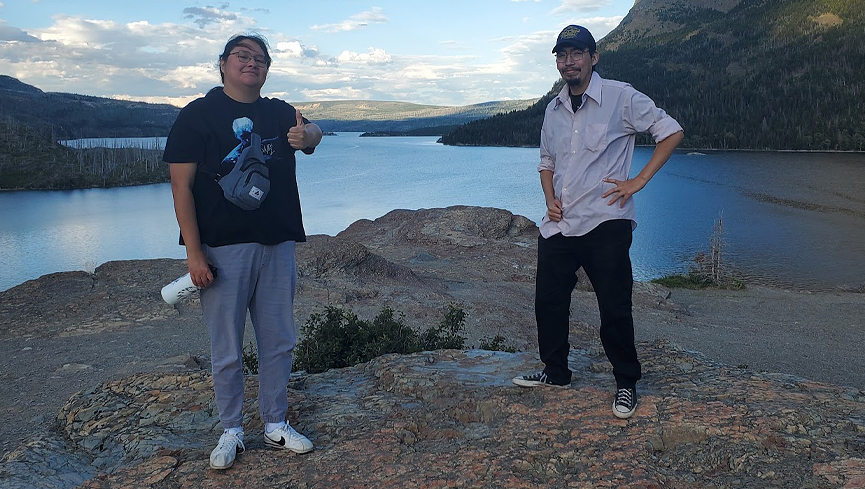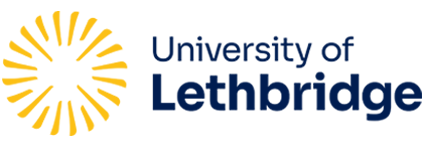Two University of Lethbridge students dived into biochemistry in a big way over the summer and became the first Indigenous undergraduate students to work at the Canadian Center for Hydrodynamics (CCH) with analytical ultracentrifugation (AUC).
Demetra (Demi) Good Rider and Thunder Crowshoe completed the Indigenous Student Success Certificate (ISSC) earlier this year. The certificate is designed to help Indigenous students make a smooth transition to university life. They enjoyed their biology and chemistry courses, and Crowshoe jumped at the chance when Beth Grier, a student recruitment officer, informed him that biochemistry professor Dr. Borries (Bo) Demeler was seeking students to work at the CCH.

“I just emailed Bo and we set up a meeting time,” says Crowshoe. “He took me around his lab and showed me the type of stuff he does and the AUC. He was also looking for more students.”
Crowshoe and Dr. Michelle Hogue, a professor and coordinator of the ISSC, recommended Good Rider, who also accepted Demeler’s offer. She signed up for a co-op position through Career Bridge, while Crowshoe did an applied study in the lab, along with another applied study already underway with Jennifer Burke, a biology instructor, in the ULethbridge herbarium.
“It was a great enrichment for our lab to be joined by Demi and Thunder this summer; they are wonderful teammates,” says Demeler. “They not only impressed us with their scientific acumen, but also generously shared their culture with all of us and invited our lab to their tribe’s powwow in Brocket — a wonderful experience for everyone. We now look forward to opening up the world of biophysics to other interested Indigenous students.”
At the CCH, Crowshoe’s project focused on the purification of DNA and RNA. Good Rider’s project involved creating a plasmid design to develop a calibration standard for the AUC instrument.
“Coming into a biochem job like this, I had no idea what was going to be happening or what I was going to be doing,” says Good Rider. “I’ve done both biology and chemistry, but I’ve never done them together in this sort of sense. It was really interesting to see all the things that we were able to accomplish this summer.”
“I was looking for a job like this because I love science and especially mathematics,” says Crowshoe. “I have Crohn’s disease, and it can affect me in a way that I can’t do physical work. This job was a good fit, and it really opened the door for me.”
In addition to working on their projects, Crowshoe and Good Rider travelled to Missoula, Montana, twice over the summer. They presented posters about their projects at Day of Discovery, a science conference, in Pablo, MT, which is the headquarters for the Flathead Indian Reservation and home to Salish Kootenai College, which hosted the conference. They also participated in the annual AUC workshop at the University of Montana.
Both students decided to continue their practical work experience at ULethbridge this fall. Good Rider, a kinesiology major, is doing a co-op work term with the Building Brains Together team, teaching traditional Indigenous games to children. Crowshoe will continue his work in Demeler’s lab and has decided to switch his major to biochemistry. He’s also a recipient of an I.D.E.A.L. Scholarship through BioTalent Canada. The scholarship is designed to promote inclusion, diversity, equity and accessibility leadership in STEM studies in Canada.
“This fall, I’ll be able to be in charge of my own project, with a little supervision, and run experiments in the AUC, continue my career in the lab,” he says. “Crohn’s disease can actually attack everything in your body; it’s not just your gut. They don’t really know the cause of it; it hasn’t really been researched that much, so maybe for my PhD, I can pursue that as research.”
Good Rider chose kinesiology after learning that her grandfather had once been diagnosed with diabetes and how his walking habits, from one side of the city to the other, contributed to the reversal of his diabetes.
“That’s when I started thinking about First Nations health and kinesiology,” she says. “There are so many unanswered questions around Indigenous health that I would like to explore.”
